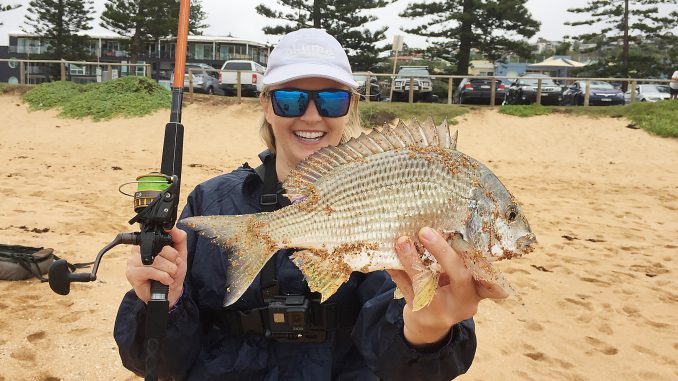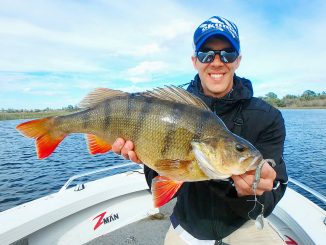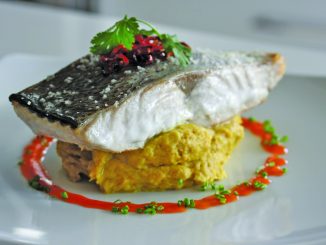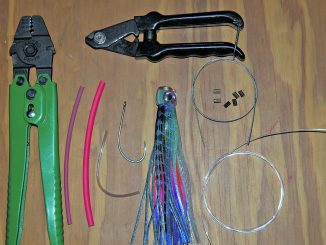
by Alex Bellissimo •
I spend just as much time rock fishing as beach fishing, but there’s something particularly special about fishing the ocean beaches. You’re right amongst the waves and wind, up close and personal with nature, and it’s a unique, primal feeling.
To be consistently successful on the beaches, you need to know how to ‘read’ a beach, which means identifying structures like holes, gutters and rips, and why the swell is larger on one side of the beach compared to the other. The importance of tides, the correct gear for the target species, the correct bait and lures and appropriate techniques is a process that will take time, but it’s a lot of fun along the way!
For now, let’s break it down to basics and take it step by step.
BEACH STRUCTURE
A good place to start is with a stroll down the beach without the fishing gear. Why? Well, if you’re just starting to learn about beach structures, it will pay for you big time to check out the difference between a sand bar, a beach hole or gutter, or a rip. You can’t just rely on fishing near another angler and hope they know what they’re doing. If you can’t identify beach structure, you’re going to catch far less than you should catch off an ocean beach – even if you’re an experienced angler in your own field.
Have a look on Google Maps for a likely beach to check out. Ideally you want a beach that’s at least 1.2km, preferably longer. The longer the beach, the more holes gutters and sandbanks of variable depths there will be, and the more fishing possibilities and options that you should avoid.
In the photos hereabouts you will notice a section of water that has less or no wave foam. That is the deeper area of water, or hole, that you should fish. On the left and right of that deeper water is white foam, which is a sign that the water is probably shallow. This shallow water area is called the sand bank.
The beach hole becomes deeper and wider during the high tide period and has a more narrow gutter passage during the low tide period.
Now let’s do a basic run-down on bait collecting. The following baits will catch bream, whiting, dart, flathead, trevally, tarwhine and even mulloway. When you’re gathering bait, remember to take only what you need.
BEACHWORMING
Beachworms are one of the main baits I use for whiting and even bream off the ocean beaches. Catching your own worms can be challenging at first, but also a lot of fun.
The best locations are the more open larger beaches; small beaches don’t usually have good numbers. The best time is low tide, around one hour before to roughly one hour in.
When it comes to bait, I use pilchards, salmon fillet, tailor fillet or any oily fillet salted (salted fish give a long lasting smell). Some wormers use canned kippers, which work well, while others use rotten fish.
I put my bait in a sock or stocking, take a 1.5m cord and half hitch the top section of the sock. I then half hitch the cord around my wrist. Some people use their sock for berley and hold a bait in their other hand, but I just use the sock as both berley and bait. I also take a bait bucket, belt and a small bucket.
When you’re on the beach at low tide, look for spots that have a flat area and a longer run-off where the wave reaches its maximum and recedes to its minimum. You can tell where the beach hole is because the waves break less, and don’t travel as far up the beach, which isn’t ideal for worming.
Go to the flatter section of beach 10-20m away from the minimum of the wave receding. Lower the bag down and have approximately 1m of cord with your sock filled with burley. Wave around your bag of berley/hand bait when the wave is at its maximum and at the beginning of the water receding, and then wave the bag in a fan-like motion. That will send a berley scent towards the waiting worms.
If you see a V in the shallow water (only a couple of centimetres) there’s a beach worm there. Worms don’t have eyes but they can sense vibrations, so tread lightly towards the worm. When you have reached the worm, wait for another wave and then place the bag near it. The worm should raise its head again. Put the bag within a millimetre of the worm. The worm has two black pincers which will come out and grab the bag. Place your fingers gently into the sand and press onto the worm firmly and turn your wrist which will allow you to get a better hold of the worm. They are slippery buggers so get some sand in between your fingers to give you a better grip.
The medium size worms are easier to catch, so I recommend that you practice on that size. With the big worms you will often lose grip because they are strong and slippery, or you will over grip them and bust off the first few centimetres of the worm. Timing is critical to pull them out without snapping the head section off.
When you have enough worms you can roll them in cool, dry sand or put them in a bucket with an aerator and around 15cm of cool salt water. That will keep them alive for around 2-3 days. Keep a spare bucket so you can change the water, and get rid of any broken worms as they will pollute the water. Whether your worms are in sand or water, be sure to keep them in the coolest storage area possible (e.g. the bathroom). Hot areas will kill your hard-earned worms.
GATHERING PIPIS
Pipis are a great whiting bait. Harvesting them is great fun, and anyone can do it. It’s best done from the half run-out to the half run-in tide. The more open, larger beaches are best.
Find an area similar to where you’d catch beach worms, and get ready to do the ‘pipi shuffle’! Stand at a similar distance as beach worming, around 10-15m away from the minimum of the draw back of the wave. With your feet next to each other, weave your feet into the sand as the water is receding. That will help your feet shuffle away sand, and as the wave is receding allow you to bury deeper in the sand. You’ll either feel the pipis with your feet, or will see them in the water, and you’ll need to quickly grab them before they get washed away. The larger ones are best (around 8cm long by 6cm wide) so you can get enough pipi bait to cover your hook.
BLOODWORMS
Digging bloodworms in estuaries can be well worthwhile, although it’s hard work. Before you start though, you have to find out where you can legally harvest them, and what the bag limits are. The DPI website can tell you this.
Bloodworms are generally dug on the mud flats. It’s laborious, messy and smelly, but if you stick with it you’ll get some great bait. Having a decent size shovel will give you better results. Dig and turn over the shovel full of mud, and break apart the black dirt/mud to look for the worms, which are a deep red colour. Please take only what you need.
PINK NIPPERS
In the estuaries at low tide, there are areas of exposed sand flats which are home to pink nippers. Some estuaries can have dozens of acres of low tide sand flat prospects. Look for the nippers’ holes, which have small mounds on them. When you see a hole, place the yabby pump on it and push down to create a seal, and then pull the handle to suck up the sand. Spray it on the ground away from the hole. Quickly repeat the task on the same hole (within seconds). If you haven’t had luck after 3-4 tries, go to the next hole.
If the sand is too gritty or too muddy, move to a more sandy spot, which will give you better results. This could be only a few metres away.
CHOOSE YOUR TARGET
You may have already decided what species you want to catch off the beach (e.g. mulloway), and don’t want to catch anything else. If you’re an experienced angler in other areas, and you’re prepared to put in the hours, that’s fine. However, if you’re new to fishing, or if you don’t want to spend too long between bites, I recommend targeting bread-and-butter species such as whiting, bream and tailor. They will keep you occupied and interested, and will require a lot more casting and fiddling around, which is great – it will help you become more coordinated and improve your dexterity.
If you prefer to go for something larger, you can target the dusky whaler shark or the often elusive mulloway. Basic mulloway fishing off the beach is doable for an intermediate angler, but novices can become frustrated with the slow results. We can look more closely at this species later in the article. For now, let’s look at the bread and butter species.
WHITING AND BREAM
I prefer the months between mid October to late June for whiting and bream (and also for flathead, dart and tarwhine). There are periods throughout the season that produce better results, but this varies from year to year and from the South Coast to the North Coast.
Whiting and bream are bottom feeders, foraging for pipis, small crabs and beach worms. Around the low-tide period the whiting, bream, dart and tarwhine can’t feed as efficiently as when the tide is at least half tide in to the high tide. That’s because the pipis, small crabs and worms are above the low tide water line.
These fish can be found in a variety of depths, but some depths are better than others. You can fish a deep gutter around 4m and have some success, but your results will probably be better fishing the shallower gutters around 2m deep – or even as little as 75cm, especially during flat surf.
Bait
Having the best baits for whiting off the beach is important. Whiting love worms, such as beachworms, tubeworms, bloodworms and squirtworms. You’d think beachworms would be the best, seeing as they’re in the same area as the whiting, but bloodworms are at least as good. You can also pump squirtworms or pink nippers.
Whichever bait you’re after, be sure to check out the areas where you can legally harvest it, and check the bag limits. You can find this info here.
Alternatively, you can purchase these baits from a tackle shop which specialises in live bait. Just be sure to call the shop first to make sure they’re in stock. You may have to place an order and arrange a meeting time at the shop.
Rod and reel
Although you can catch these species on a heavy rod and reel, your results won’t be as good as with a light spinning reel or Alvey set-up. A long, whippy-tipped light rod with a medium action is best. Go for a 3.2-3.6m (10’6”-12’) rod that can handle sinker weights up to 2oz, as this will handle most surf situations that you would fish. Fishing a swell size above 1.5m is quite challenging, and you should avoid it.
For the low reel seat rod, I use an Alvey 500B side cast reel. For the medium seat rods, I use a 300 size spin reel.
A durable shoulder bag like an Alvey Wading Bag is a must. You should also bring a cloth to wipe your hands with, as well as a rod bucket, belt and bait bucket. A 15-20L bucket with a clip seal lid will hold your catch. Ready-made 2-hook paternosters or single hook rigs will save you the fuss of re-rigging during a hot bite.
Line and terminal tackle
The line class is 3.5-4.5kg (8-10lb), as the sinker weight can be fairly heavy during moderate swell conditions. You can fish 2.6kg (6lb) braid or mono but it will put a strain on the line, or even snap it if you’re using 2oz sinkers. I recommend braid plus 10-12lb fluoro leader for your spin outfits. If you’re using an Alvey or just prefer mono, try 8-10lb mono.
The smaller the swivel, the better. I use 44lb swivels. You’ll also want snap clips for your sinkers so you can change the sinker weight with ease. If conditions are flat, having your sinker anchored to the ocean floor may reduce your chances. Changing the sinker weight in accordance with the wave action and current speed will give you better results. It looks more natural if the bait is bouncing along.
You may have been told to use small hooks for whiting, and this is true when you’re using skinny tubeworms. However, most of the time it’s not necessary. Small hooks are more likely to deep hook undersized whiting and bream, reducing their survival rate and making life harder for the angler as well. I use a no. 1 or 2 red long shank hooks.
TAILOR AND SALMON
Catching a big salmon is what got me hooked on beach fishing. I was 13 years old fishing the northern side of Seven Mile Beach on the South Coast, and was using a whole pilchard on a set of three 3/0 gangs with my trusty 7’6” glass rod and my 600B Alvey with 12lb line. The full moon was just rising off the horizon. The rod tip loaded up, and a few seconds later a 2.5kg salmon jumped directly in front of the moon! Playing it out was amazing, and from there I got right into fishing with ganged pilchards in the surf.
The peak time to catch Aussie salmon is from around mid May to November. The best time for tailor locally is from October until the end of July.
Tailor and salmon are generally caught in the same gutters as mulloway and sharks. They can even be caught in shallow gutters as they forage for mullet, whitebait and any small fish which gets too close.
Tailor and salmon are pelagics, which means they are free roaming, rather than living in one place for extended periods like bottom species tend to do. Tailor and salmon will look for baitfish in and on the edge of gutters and holes, and often move on unless there’s enough prey to keep them berleyed up. These predators are even found on top of sand banks and in shallow gutters during flat sea conditions.
To catch tailor or salmon, fish the edge of a gutter where the white water ends and the deeper green or aqua coloured clearer water begins. Usually gutters and holes are between 20-50m wide, and some can be fished at low tide if they’re deep enough. Some are better fished from the fourth hour in up to two hours out, because the gutter may be too shallow before that stage of the tide.
These predators like to use stealth to ambush their prey. Once the baitfish know they’re being hunted, they will escape into the shallower white water and hide there.
Rod and reel
You need a rod and reel setup that can fish up to 112g of sinker, plus the weight of your sizeable gang hooks and pilchard. That can be around 160g or slightly more if you’re using large pillies. I recommend a 12-13.6ft rod, either 6-10kg or 7-15kg.
When it comes to reels, the 600-650 size Alvey reels are good, and are suitable for a reasonably quick retrieve. I have found that 10kg mono is heavy enough to deal with 4oz sinkers, or you can fish lighter in that 6kg line class.
If you prefer spinning reels, a 4000-4500 size reel is the go.
Line and terminal tackle
When I’m chasing these fish I use 10kg braid coupled with 20-30lb fluoro leader. I recommend a 95lb crane or rolling swivel, and 3/0 to 4/0 gang hooks. It’s a good idea to bring two sizes to suit different size pilchards.
Suitable sinkers are 1/2oz to 4oz in a star sinker, bean, or even a large ball sinker. If there is a lot of side sweeping current, stick to the star sinker, which drifts less.
You can get good results by adding a surf popper to your rig. Sometimes you will get the strike with this rather than a pilchard.
It’s up to you as to whether you want to purchase the 2kg block of pilchards or the IQF (individually quick frozen) variety. IQF pilchards are slightly firmer, and so can withstand the strong current and waves action a little bit better.
MULLOWAY AND SHARKS
Most beach anglers regard the mulloway (jewfish) as the pinnacle of beach fishing. They’re also the most elusive species for us East Coast anglers off the beach, at least in the Sydney region. If you head north or south of Sydney you have a better chance of landing one.
Both mulloway and sharks prefer mild water temperatures, so mid-October to June is the best time in the Sydney region.
Times, tides and moon phases
The best time of the year to target mulloway is between October and June. As the whiting, dart and mullet move in on the beach and the increasing numbers of tailor prowl the beaches, the mulloway and sharks come in to feed. The cooler months don’t fish as well; there’s less variety of bait, and the mulloway prefer water temperatures of 19°C or above.
Most anglers prefer to fish for mulloway from the fourth hour of the run-in to around one hour of the run-out. This can vary from fishing the deeper gutters compared to fishing the shallow gutters.
When it comes to moon phases, there’s a mind set to only fish the new moon because it’s the dark phase of the moon, although some anglers will fish the build-up to the full moon period.
For me, the full moon and new moon period mean that the tides are at the correct time of the evening. The high tides in NSW will be approximately 1-3 hours after dark during the peak of the full or the new moon phase. I call this ‘social hours fishing’, as the average person can fish the high tides up to about 8-10pm and get home and have a decent sleep for work. Another advantage of fishing the earlier tides is that it’s still light enough for you to check out likely prospects. You can check out your plan A gutter and find a plan B or C. Finding a gutter at night is a daunting task for all but the most experienced anglers.
Fishing later into the night can be advantageous though, as the locations you’ll often fish will have swimming pool lights nearby, which create a lot of light. Generally they shut the pool lights by 10pm, so the late tides are good for that reason.
I like to set up my gear near one side of the gutter between the wave foam (the shallower sand flat) and the unbroken waves (the drop-off of the beach hole).
Bait
Most mulloway anglers use squid, and the fresher the better. Some anglers simply won’t go mulloway fishing if they don’t catch enough squid, or can’t buy quality squid.
But here’s a heads up – there are no weed beds on 99% of all East Coast beaches. That means the mulloway’s prey is not squid, but small to medium size fish. Yes, squid does make great bait, but it’s not the be all and end all.
Live bait like mullet can be caught from the estuary, or you can use slab baits like yellowtail mullet or even slimy mackerel. Legal whiting make a great live bait, and are great as a fillet or butterflied bait as well. Tailor are also an excellent mulloway bait.
Beachworms aren’t often used, although mulloway do forage for beachworms off our ocean beaches. If you want to use beach worms, use the larger ones for these big predators.
Tackle
You can scrape by with your tailor and salmon rod in swell conditions below a metre, but it won’t be suitable for all-round beach mulloway fishing. When the current and swell is a little larger than a metre, and the baits you want to use are double the weight of even a large pilchard, your tailor and salmon gear may not cut it.
A sturdy rod is required, and one that is preferably from 3.6m (12’) to 4.5m (15’). The rod should be capable of handling at least 250g, and preferably more – even up to 350g. That’s a lot of weight to cast, so a rod with a flimsy tip that bends over before you even cast out is going to give you a spongy, smaller cast, and not handle the heavy weights you may require. I use a 7-15kg, 2-piece, 3.6m (12’) rod, and 10-20kg, 3-piece, 4.5m (15’) rod. I couple these with a 4000 size reel spooled with 30lb braid and 40lb leader.
When using an Alvey, I use a 15’6”, 10-15kg rod. The length takes some getting used to, but it’s an advantage when the surf is up to a moderate swell.
BEACH FISHING TIPS
Fishing the correct sinker weight can add to your catch rate off the surf beaches. For example, if you’re fishing for tailor in slight wind and wave conditions, you can cast out a light sinker and a pilchard or medium-size gar unweighted, or with a sinker weight of only a few grams. It may not sound practical, but it works well when you have found a deep gutter in close. Just casting out and slowly retrieving your bait back in can give you great results.
However, more often you’ll need to fish sinker weights from 1-2oz, and on at least half of all of your trips 2-3oz would be more practical – sometimes even heavier, depending on the species.
For whiting and bream, use 1/4oz-1oz as a general rule. When the swell is 1m+, up to 2oz is the maximum for light outfits.
For sharks and mulloway you can start with a 2oz weight and go up to 6oz. Why so heavy? Well, large baits create more water drift during moderate swell conditions, and the current will move the sinker as well if it’s not heavy enough.
Most of the time when fishing off the beach, the line tilts from 12 o’clock to 1 o’clock, or from 12 o’clock to 11 o’clock angle. If you don’t walk with the direction that the line is moving to, your line could eventually wash up onto the beach. Moving with the line direction and keeping your line fairly straight out at 90° will help you cover more water in search of your target species, and will reduce your line getting washed onto the beach. Vary your sinker weight according to how much current there is.
TRYING IT YOURSELF
So that’s your basic guide to beach fishing. Beach fishing is a safe and sociable option, keeps you fit, provides great sportfishing and quality eating fish, and it’s just a beautiful place to be.
Give it a go, you’ll love it!
Alex Bellissimo is Sydney’s most popular rock and beach fishing guide, catering to both beginners and experienced anglers. Prices start from as little as $175 per person when you book a trip with 3 friends. To see the latest catch photos check out Alex’s Facebook page, or for more info on trip options visit his website.

















